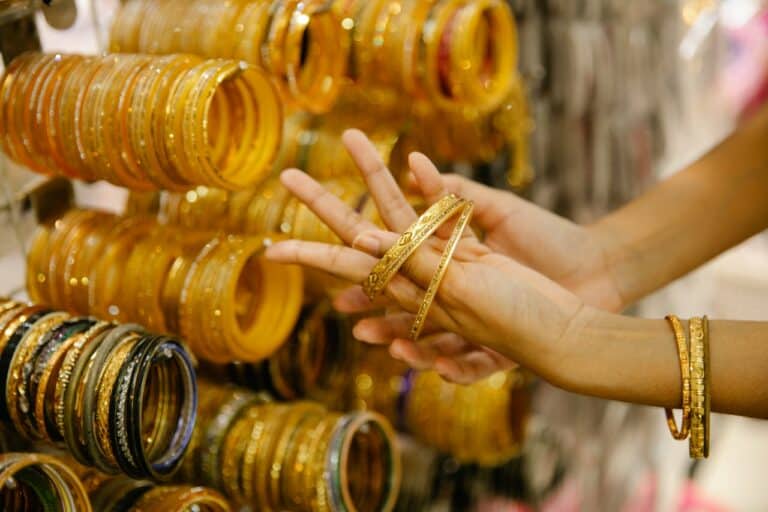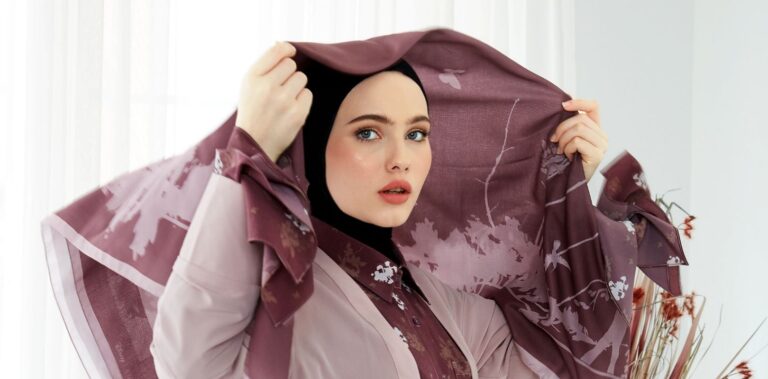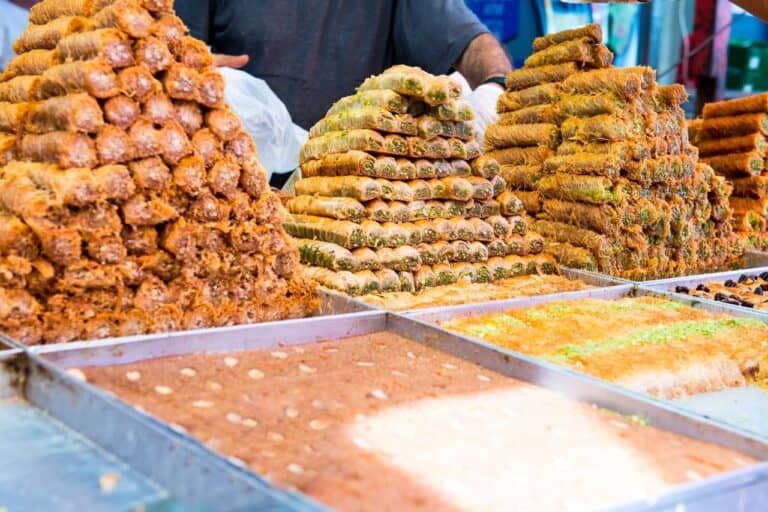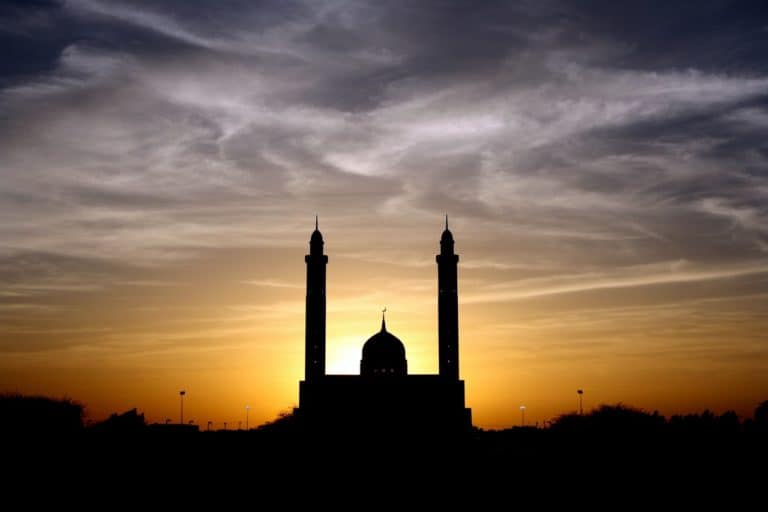Dubai Traditional dress; 10 basics of Emirati clothes
The clothes of UAE and Dubai Traditional dress come from a land of scorching deserts. Their garments share a captivating history, evolving from Islamic traditions and the region’s connections with the British Empire.
An infusion of the nomadic Bedouin way of life with a modern twist has created the stylish Emirati fashion we admire today.
Today’s UAE national dress is influenced by those three elements. To understand how and why, let’s delve deeper into the history of the region and how it changed the Emirati dress through time.
We’ll learn the Arabic names of the garments and some remarkable places in Dubai to buy them for yourself. Plus answer all those burning questions.
As a wife to a Saudi national and with many Emirati friends, I spoke to Khaleejis (people from the Arabian Gulf) to dispel the myths and correct common mistakes when tourists wear traditional Emirati clothes.
So let’s find out more about what the Dubai sheikh wears and discover the rich cultural tapestry woven into every garment!
What are the names of Emirati clothes?
In summary, these are the names of the 10 different items of clothing that make up a traditional Emirati outfit. See the images and explanations further down.
Men
- Kandura
- Ghutra
- Agal
- Bisht
- Gafiyha
Women
- Abaya
- Shayla
- Jalabiya
- Burqu or Battoulah
- Niqab
Dubai National dress for men
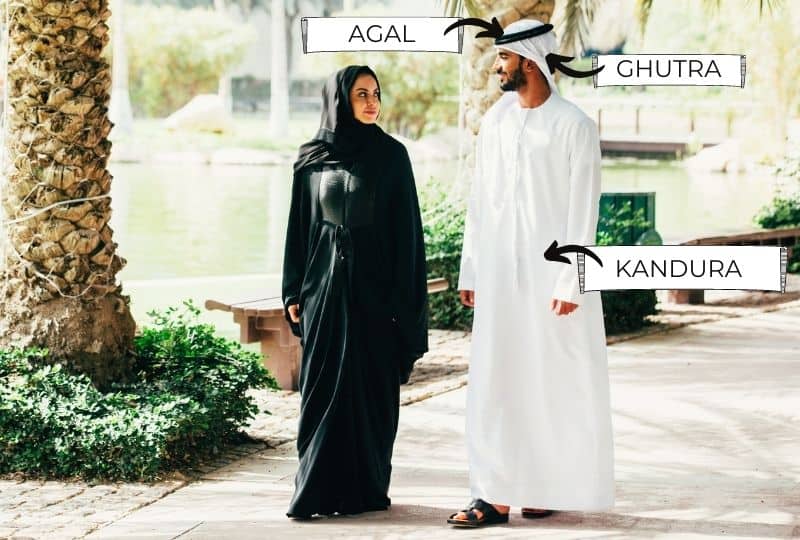
The traditional dress for Emirati men is made up of four key items:
- Kandura
- Ghutra
- Agal
- Bisht – only for special occasions
The Kandura is a main part of Emirati male clothing, consisting of what looks like a very long white shirt. The Emirati style has a low collar with long plaited strings that hang down the middle.
The formal look is completed with a large white cloth placed on the head and held in place by a black ring called an agal.
Across the Gulf, Arab traditional clothing for men typically with variations of the collar, as you can see below. Oman is the most similar to the Emirates however the strings, called tarboosh, are placed to the side.
The Kandura is popular all over the Middle East, with differences in the name such as calling it a dishdasha or thawb.

The Ghutra is the name for the fabric placed on the head, traditionally white in the Emirates.
It’s folded into a triangle before placing it on the head. It’s also wrapped in a turban style, nicknamed a hamdaniyah, without the Agal and is also very popular.
The same headpiece is called a Shamagh in Saudi and other Gulf countries. Either worn on the head flat or in a turban style like The Emirates.
It is called a Keffiyeh in other countries in the Middle East.
A small cap is worn underneath to keep everything in place called a Gahfiya (in the picture below). The Agal, sometimes spelt Igal or Egal, is the black band that goes on top and is the final piece.
There are many different ways to fold and style the fabric depending on the preference of the man.
The Agal also has an interesting history! It was used as a camel hobble at night to tie the front legs of the camel together and echoes the bedouin history of the UAE.

The Bisht is a long decorative cloak that goes over the Kandura. It is usually only worn for special occasions or by dignitaries. If you get the chance to see an Emirati wedding, this is how you can tell who the groom is!
🐪 Book a traditional Emirati cultural experience with a desert safari 🐪
So why is the Kandura white?
It may seem impractical to herd camels wearing white, so where does it come from? In the early days of Islam, Prophet Muhammad encouraged his male followers to wear white.
This tradition is popular to this day, white represents cleanliness, purity and modesty.
What do men wear under the Kandura?
We know you’ve secretly wanted to ask this question! What should be worn underneath?
Men wear white underwear, since colours are very visible, along with long shorts or fabric wrapped around the waist. This helps avoid an exposed undergarment faux pas and gives the kandura a nice, smooth look.
On the top, it’s common to either wear a plain white t-shirt or vest under the Kandura. This stops the fabric from rubbing and chaffing and adds extra coverage. It also ensures the Kandura looks nice and smooth over the body.
So now you know! Also if you’re a tourist planning to wear one, make sure to take care of these details! I’ve seen too many running around Dubai Mall making this fatal faux pas. No one wants to see your underwear.
What is the history of the Kandura?

So while the Ghutra and Agal have a very long history with bedouins and also serve a practical side, the Kandura is a little different. UAE men are descended from Bedouin Arabs who roamed the deserts of Arabia.
The long fabric of the Ghutra was able to be wrapped around the face to protect them from the dust and sand.
The Agal had a dual use, as it would be used to bind the front legs of the camel together called a hobble while they slept at night in the desert.
The history of the Kandura is unique. As you may have noticed, the modern version today looks similar to a tailored shirt at the top. The style was inspired by the British and Americans present in the region as formal shirts were popular during this time. Especially in the 1960s when the popularity of tailours grew in the region.
The Kandura or Thobe (Thawb) before this era were often plain gowns and it was popular to wear a jacket over the top.
Is this also the Dubai traditional dress?
Yes, the Kandura is also the Dubai national dress and the national dress of UAE. Meaning it’s worn across the country in places like Abu Dhabi and Ras Al Khaimah as well as Dubai.
Dubai’s traditional clothing does not have a different collar or style to the other UAE dress. The colour differences you see in the Arabic Kandura dress are mostly a fashion choice however certain colours are more popular in winter with slightly thicker fabrics.
Variations of the Kandura
There are variations based on the seasons and slightly thicker fabrics are used during winter seasons along with different coloured Kandura, UAE is however still quite warm even in winter. So not all will choose to wear the thicker fabrics.
You’ll also see different colour variations, the yellow colour was made popular by the ruler of Dubai; Sheikh Mohammad bin Rashid Al Maktoum. This colour wasn’t often seen before this.
Other popular colours can be shades of blue or grey but the most commonly worn is the white colour.
What is the traditional dress of UAE for ladies?
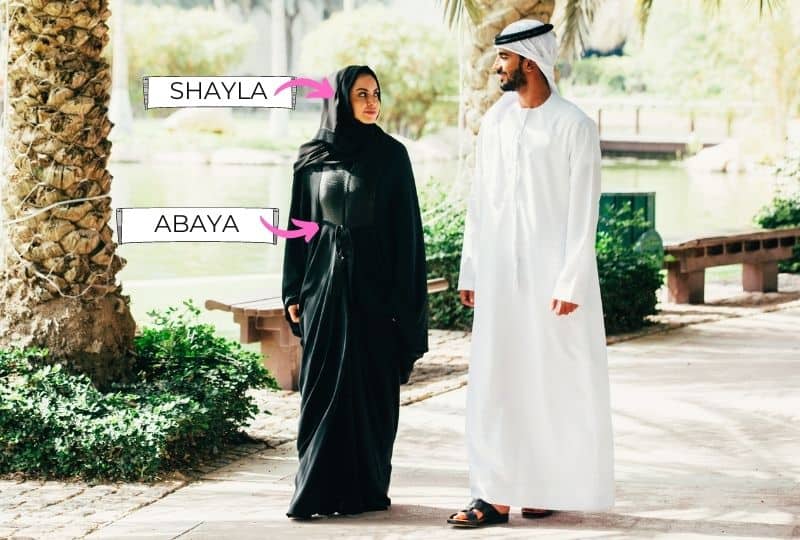
For women, the UAE traditional dress is made up of three key items along with an optional third:
- Abaya
- Shayla
- Jalabiya
- Burqu or Battoulah
- Niqab
The abaya is a traditional long loose black cloak which goes over the clothes of a woman. It comes from Islamic principles which should hide the body shape of the woman to preserve her modesty. The Shayla is the black scarf which covers the hair and the Jalibiya is a colourful traditional UAE dress that is worn underneath. Finally, the Burqa in its traditional form is a gold mask, still worn by elderly Emirati women today.
Historically, it wasn’t always black and different colours other than black are gaining popularity in Dubai along with the rest of the Emirates.
The Shayla, also called a hijab, is a piece of cloth that is wrapped around the head and covers the hair of the woman. In the Gulf, it is popular to wrap it twice around the head. It’s also popular in UAE for women to wear it quite loose and have a little bit of hair showing at the front.
The Battoulah or Burqu, in the Emirati dialect pronounced Burghu, is traditionally a metal mask or fabric that is made to look like metal. Worn to cover part of the face, mostly the nose, mouth and part of the chin.
Niqab, is a piece of cloth that goes over the face and has a gap for the eyes. It was very common for women to veil their faces in the past and you may see Emirati women wearing it today. However, in more recent times, it is becoming less common.

The names have evolved to have slightly different meanings over time, for instance, niqab would usually now mean the black cloth with an opening for the eyes while the burka covers the woman completely with mesh for the eyes.
In the UAE there is another part sometimes worn called a Gashwa, this is a hood that goes on the woman’s head and is typically worn with a niqab. Commonly the forehead is exposed and a veil covers the nose, mouth and chin. I’ve rarely these this one in Dubai but it can be popular in the more Bedioun areas of the UAE.
A Gashwa or Gishwa is not a niqab, it is the hood part. As other websites incorrectly suggest.
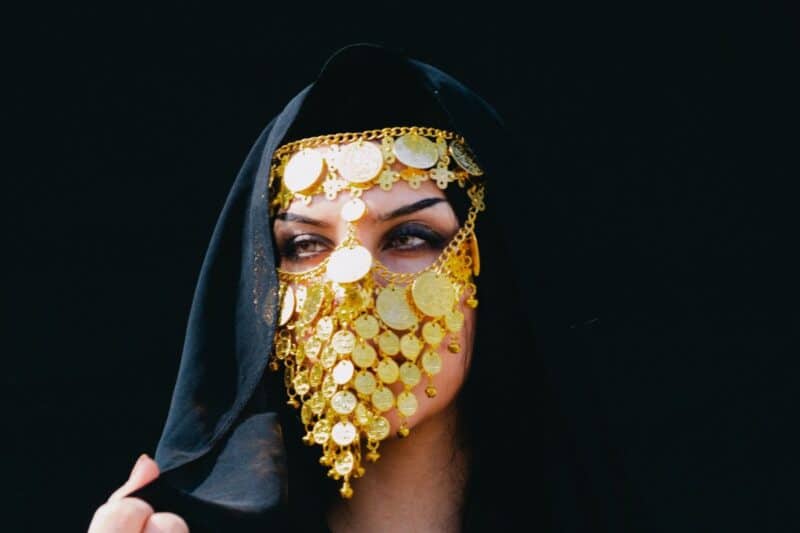
What is the history of wearing all black?
We’re not sure where the colour black came from but it is a more modern invention as we can see historically yellow and red were popular colours in the Islamic era according to Islamic texts.
You can learn more about why women wear hijab in my previous article here
What do women wear under the Abaya?

So the UAE traditional clothes also include a colourful dress called a Jalabiya that typically has long sleeves and reaches the ankles or lower. The Emirati style has a decorated neck and this would be normally worn around the house.
Whenever the woman wants to go out, she just takes the Abaya and Shayla to cover over the Jalabiya. It is common in the UAE to buy as a pattern with the fabric and take it to a tailor to be made.
Now in modern times, many women wear Western-style clothes underneath. Whether it’s comfy loose-fitting trousers and a T-shirt or sometimes even pyjamas but shush don’t tell anyone.
I wear Jalabiyas pretty frequently and they’re so comfy to wear around the house. Plus it’s an easy choice if you’re working from home or a stay-at-home Mum. The perfect house dress!
Have a look at more Jalabiyas
Use code DANNI10 for up to 20% off
FAQs about traditional dress in Dubai
Who wears the traditional dress of the UAE?
So typically the Kandura is worn by Emiratis but it is also popular for those who enjoy living in the country or who have lived there for a long time to wear it too. You may find other nationalities when it’s a special occasion such as a wedding, jummah prayers, UAE national day or ramadan that they wear it too.
The abaya and shayla is typically worn by women in the gulf region however many Muslim women regardless of their nationality will wear it here. It is still more associated with Khaleeji women in the style but again many women who have lived in the region for a long time will wear it too.
Can tourists wear a kandura?
Yes there isn’t an issue for tourists to wear the kandura and frequently you will see tourists running around in them in Dubai Mall and locals are happy to share their culture for those willing to learn.
Though of course be respectful in the clothes and remember there are Islamic values attached to those clothes. In fact many bars do not allow local dress and anyone who does wear local dress in such places is normally not an Emirati.
What is the old UAE traditional dress?

The Emirati traditional dress is pretty different to the dress you see today, especially for women. The black colour is something which became popular in the last 100 years.
In addition to this, women often wore a gold mask over their faces and you’ll see this mask featured in cartoons for the UAE along with other items. Some UAE women dress like this today, particularly older women.
For men, they mostly dress the same but the kandura had a more loose style that wasn’t as tailored as the modern version today but white and light colours were still popular. Along with their long length.
What is the UAE national dress for girls?
For girls, it’s different and involves colourful dresses with traditional Emirati patterns. Often they’ll incorporate the UAE flag colours or mix white, black, red and gold.
There is a traditional form of embroidery and each gulf region has a style or pattern of embroidery that is typical for their region. So sometimes you’ll see dresses that incorporate this part of their cultural history too.
What is the UAE national dress for boys?
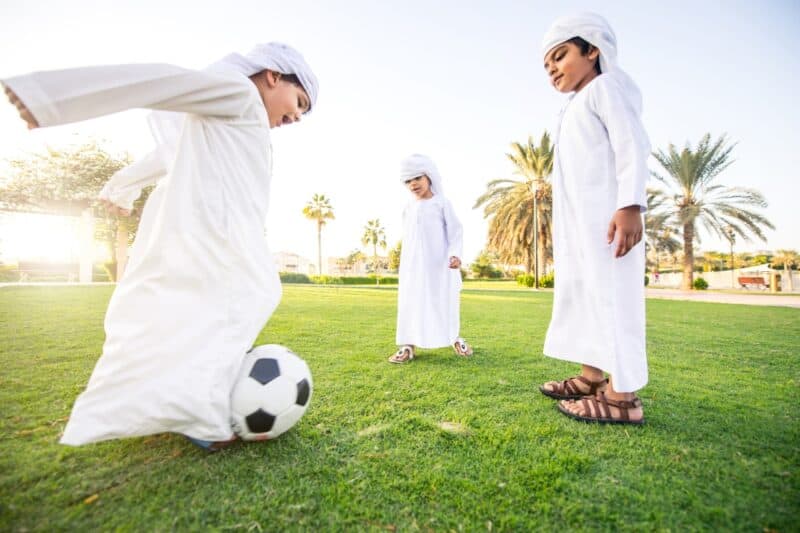
For boys, the traditional outfits are super cute mini versions of the adult version. With a kandura and ghutra wrapped in the turban style. You may see them wearing the ghutra with the agal but it’s more common in the style above.
Where can I buy traditional clothes in Dubai?
There are lots of areas where you can buy traditional clothes and the shops are separated into male and female.
For men, you’ll see large glass windows with the Kanduras on manikins. There are some shops in Dubai Mall but you’ll also find loads in Jumeirah and Umm Suqiem in Dubai as this is an area where locals tend to live. Here in these shops, you pick what fabric you like and the Kandura is tailored to fit the man.
For women, abayas are ready-made and sold at various shops throughout Dubai. Again you will find abaya shops in Dubai Mall and in places like Souq Madinat in Jumeirah. Make sure to haggle so you don’t get the tourist price!
If you’re wanting to get a good deal on an Abaya you can head to Abaya Mall in Mirdif or even Dragon Mart!
Is it okay to wear shorts in Dubai?
Yes, shorts are allowed in the UAE but it’s not typical for locals to wear shorts. For malls, the official dress code is shorts below the knee but the dress code is rarely enforced these days in Dubai with the exception of government offices.
Dubai men dress modest however this isn’t necessary for tourists visiting the UAE. To find out more about what it’s permissible to wear in Dubai, check out my article on the UAE dress code and what to wear as a tourist
Want to learn more about Dubai and the UAE? Don’t forget to check out my other articles after you’ve finished this one:
Learn even more about Dubai and it’s country with facts about the UAE
Where is Dubai? Why is Dubai so rich? The ultimate Q&A!
What is the UAE traditional food and where can I eat it in Dubai?
The Dubai Dress Code for tourists and how to dress when visiting Dubai
🐪 Book a traditional Emirati cultural experience with a desert safari 🐪
Conclusion
I hope you’ve learnt some more about the traditions and the culture of the Emirates through the UAE clothing!
It’s totally fine as an expatriate to try on the Dubai traditional dress. If you do decide to try on some of the local clothes, just make sure to be respectful as Emirati’s hugely pride themselves on their reputations which make them instantly recognised with their dress.
Make sure to experience some of the Emirate culture during your time in Dubai too with this incredible 7 hour tour in the desert featuring Emirati traditions with a camel ride and desert safari
Looking to save money while visiting or living in Dubai? Join our FREE facebook group where we help you save money on hotels, activities, dining out, nights out and more!
Read more Plan your visit to Dubai Guides
*This article contains affiliate links, as an Amazon Associate and a member of other affiliate programs, I earn a commission when you click a link and a qualifying purchase is made. (See Disclosure for more details)





